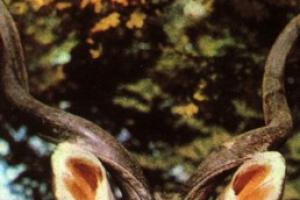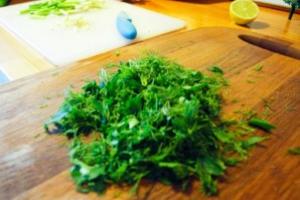There is still snow, but garden centers already have shelves with primrose pots. And who came up with the idea to name this extraordinary flower - common primrose?
Bright blue, purple and snow-white flowers can be purchased from March to May at almost any garden center. Or you can sow seeds and plant your own plants in the garden in the spring.
Primula translated from Latin as “first”: it blooms very early. And one of the first to bloom is the stemless or common primrose ( Primula acaulis, or R. vulgaris). It's small herbaceous plant with single flowers, most often white or yellow, less often pink, lilac or purple with an eye.
Often on a plant in bloom it is impossible to even see the leaves - they are completely covered by numerous flowers. Stemless primroses and its hybrids are easy to distinguish from other primroses - the flowers are solitary, not collected in an inflorescence, each on its own stem.
 The best way to get resistant primroses is to ask your neighbors and friends for clones that have been growing well for a long time. You can buy flowering specimens, then the species and variety will not be in doubt.
The best way to get resistant primroses is to ask your neighbors and friends for clones that have been growing well for a long time. You can buy flowering specimens, then the species and variety will not be in doubt.
In winter, primrose rhizomes are sometimes sold; they can be bought and stored briefly in sphagnum moss in the refrigerator, in the vegetable compartment. If they grow prematurely, plant them in pots and keep them cool, preferably on a loggia. In a room with high temperature and low humidity, planted primroses are likely to die.
Seeds of terry primroses are available on sale. But if you look at the picture, and then at the living flower more closely, you discover that there are still five petals, but they have a wavy edge and they are half-open, the middle is not visible, so the flower seems double.
Truly double (multi-petaled, without stamens and pistil) flowers are sterile and can only be propagated vegetatively. Stemless primroses also have these.
New varieties and hybrids appear every year, and it is often quite difficult to understand what is sustainable and what is not. In general, resistant primrose clones are as close as possible to the natural appearance in color and size of flowers. The flowers themselves are pastel hues, not blue and without large bracts (a collar of leaves immediately under the flower).
 The best time to plant is as soon as the snow melts, but with regular watering they will tolerate division and replanting at any time convenient for you. Primulas take root at low temperatures (planted in late summer - autumn, they often do not survive until spring).
The best time to plant is as soon as the snow melts, but with regular watering they will tolerate division and replanting at any time convenient for you. Primulas take root at low temperatures (planted in late summer - autumn, they often do not survive until spring).
Ideally, such primroses need partial shade with rich loamy soil, good nutrition (for abundant flowering), absence of both soaking and drying out. But they can also tolerate full sun, provided guaranteed watering is provided.
Primroses require almost no care. After the snow melts, clean them of dead leaves. Weed away aggressive weeds and water in hot and dry weather. Primroses respond well to mulching and fertilizing with complex mineral fertilizer.
During the flowering period and active growth primroses are fed with nitrogen or complete fertilizers, and at the end of summer - with phosphorus and potassium.
The species plants are very stable and can withstand any snowless winters. Poor wintering is usually typical for varieties that are not resistant or planted in a damp place. Blue and large-flowered primroses die first. There is no point in covering plants: they get wet more often than they freeze, and this is exactly what will happen under cover.
Stemless primroses are propagated by seeds and vegetatively. At favorable conditions Self-seeding occurs in the garden, but the easiest way is to divide them. Primroses grow well and even require periodic division.
The plant needs to be dug up, divided into separate rosettes with a knife and planted in a new place. The best time for this is the earliest spring after the snow has melted, but you can divide primroses both in bloom and before the onset of the summer heat.
Autumn division is possible, but undesirable: if a snowless winter occurs, poorly rooted plants may die. You can separate the rosettes without digging up the entire bush.
Old bushes become bare in the middle and rot due to excessive density. They should be maintained by regular (every 3-4 years) division with transplantation to a new location.
Interesting variety-series of stemless primrose
Arctic (Arctic) - large flowers of white, yellow, red, blue and other colors. Very popular variety F1 Arctic Blue with bright blue flowers with a yellow eye.
Arizona (Arizona) - simple flowers of various colors with an eye.
Dakota (Dakota) - simple flowers of various colors (pink, purple, white, orange). Up to 15 cm high.
Glory Fantastique (Glory Fantastic) - flowers with a yellow center and a border of pink, blue, crimson and white flowers.
Hether (Hetor), a very interesting variety Heather Ville Apfelblute- a plant with a white-pink flower with an eye.
Paloma (Paloma) - double flowers of various colors (pink, white, red and bright yellow). Height 10-12 cm.
Rosanna (Rosanna) - large, double, rose-like flowers of various colors (white, yellow, pink, red).
Primula stemless in the garden
 Primroses make dense borders and colorful rugs. The array can be located either near the track or at some distance from it. For one group it is worth using primroses of the same color. This is easy to do if you divide one overgrown clump.
Primroses make dense borders and colorful rugs. The array can be located either near the track or at some distance from it. For one group it is worth using primroses of the same color. This is easy to do if you divide one overgrown clump.
Primulas can be easily combined with tall perennials that will protect them from the scorching sun in summer - peonies, phlox or even roses.
Even more suitable companions when planting primroses in partial shade. There are only two restrictions here: neighbors should not cover the primroses tightly with their leaves and should not be too aggressive.
Ferns, even large ones, simply planted at the proper distance, hostas, grasses, mountain weeds, hellebores - almost the entire shady assortment - go well with them. Very good at joint plantings small-bulbous.
Large-flowered, low-winter-hardy varieties of primroses are usually grown in pots. They can survive a winter or two in the garden, but in frosty weather they will be the first candidates to be killed.
And more often than not, the more beautiful the primrose, the more unstable it is. Nevertheless, at home it will definitely die, and when planted in the garden it will delight you much longer.
Primulas are sold in small plastic pots with soil consisting of peat mixed with fertilizer beads to make the plant bloom more abundantly. This substrate is good for a “bouquet”, but in order to provide the primrose long life, she needs to be transplanted.
Select the volume of the pot twice as large as the above-ground part. Plastic bag ready soil For indoor plants mix with the same volume of coarse sand. Shake off the old soil from the roots and plant the plant in a new pot without deepening the root collar.
Water with soft, settled water, being careful not to splash water on the leaves. If the soil has become very compacted and subsided, add it to the required level.
There is an opinion that the flowers of indoor plants caught in difficult conditions winter apartment from a bright greenhouse or spacious flower shop, it's better to delete. Look at the situation, but most often, if the plant is really having a hard time, it stops blooming.
The next stage is choosing a place in the house. It should be cool, with a temperature not much above zero, up to a maximum of +12...+15 °C.
Primrose also needs to be provided with bright lighting, protection from direct sunlight, and high humidity. Room dryness is disastrous for it, and spraying will not help the matter. It is better to put the pot in a greenhouse.
Sowing primrose for seedlings
 Plants from seeds collected in your garden do not retain varietal characteristics, but this is how you can get new interesting colors. Before sowing, store primrose seed pods at a temperature no higher than +5...+7°C.
Plants from seeds collected in your garden do not retain varietal characteristics, but this is how you can get new interesting colors. Before sowing, store primrose seed pods at a temperature no higher than +5...+7°C.
Before sowing, carefully shake out the seeds from the dried fruits over a saucer. Treat seeds collected in the garden to protect the seedlings from fungi. To do this, prepare a 0.5-1.0% solution of potassium permanganate. Place the seeds in the prepared potassium permanganate solution for 20 minutes. There is no need to process purchased seeds; just steam the soil.
Spread clean snow on the soil in a container and scatter the seeds - this way they will end up evenly and without embedding on the soil surface. The snow needs to be compacted after sowing.
Cover the container with a lid. Fresh seeds usually germinate after a short cooling, so the container with the seeds should be kept in the refrigerator or under snow for 2-4 weeks.
Crops that have undergone stratification can be placed on a bright window, shaded from direct sunlight. The optimal temperature for seedling development is +16…+18°C. When two true leaves appear, the seedlings dive. To do this, carefully pry up the large nests without damaging the roots and place them on a saucer.
Divide the seedlings one by one and plant them in a box at 5 cm intervals or in individual pots. Pour in a thin stream of water. In the future, young plants need to be regularly watered and fed.
The grown seedlings in June after the end of the threat of frost in the same container can be buried in a semi-shaded place in the garden until the end of summer. On permanent place It is better to plant plants in the second half of August, when cool and rainy weather, at a distance of 25-30 cm from each other.

Olga Bondareva, Olga Petina
The first flowers welcome spring with us. For the most part, these are representatives of bulbous plants. They are tender, fragile and a little cold, just like the first spring months. Therefore, against the background of these flowers, the perennial primrose especially stands out, from which it breathes the warmth of the sun and the promise of a long-awaited summer.
Primrose or primrose (Primula) family Primroses are rhizomatous herbaceous low perennial plants that bloom mainly in spring, although there are some summer-flowering species. Whole wrinkled leaves have a slight edge; they form a basal rosette. Flowering stems do not have leaves. The flowers come in a surprisingly diverse range of colors, sometimes in two or even three colors. They are located singly on peduncles or form various inflorescences. After flowering, a capsule fruit with small dark brown seeds is formed. All species reproduce well by seed, and many by dividing the bush. You can find out more about caring for primroses.

This flower is distributed all over the world, therefore it has many species, more than four hundred. In almost every country it is shrouded in legends and myths and is considered medicinal and mystical. Primrose is called for its early flowering spring primroses, for the wavy pubescent leaves - “rams”, and also “keys”, since the inflorescence resembles a bunch of small keys.
In the spring, missing warmth and flowers, we greet bulbous primroses with special tenderness and joy. The largest of...
Classifications of primroses
Although primroses have been well studied and described by botanists, their enormous diversity makes classification quite difficult.
A single universal classification has not yet been created. Officially, the genus primrose is divided into 7 subgenera: Sphondylia, Auricullastrum, Primula, Auganthus, Carolinella, Aleuritia, Craibia.
These plants differ from each other in shape, size, color of flowers and leaves, type of inflorescences, flowering dates, that is, morphological characteristics. On this basis, 23 (sometimes 30 or 38) sections or groups were identified.
The English Royal Horticultural Society has compiled its own, easier-to-use classification, which divides primroses into 3 large groups.
For practical use, flower growers have divided them into groups based on the shape of the inflorescences and their location.
Let us briefly consider these classification options.
Classification according to morphological characteristics
As we have already indicated above, the classification of primroses according to external signs allocates 23-38 sections. Let's consider only those species that can be grown in our country (approximately in the middle zone).
1. Powdery primrose
Mealy primrose (Primula fariaosa, Aleuritia). Characteristic feature This group is the presence of a white or yellow coating on plants. Small flowers form umbrella inflorescences. These are moisture-loving plants that require little shelter for the winter and are short-lived. This section includes more than 80 species.
Powdery primrose  Primrose Hallera
Primrose Hallera
Let's name just a few of them. This is a native of the Balkans, dense-leaved primrose (Primula frondosa), originally from the Alpine and Carpathian mountains, Haller's primrose (Primula halleri), mealy primrose (Primula fariaosa) grows in the Far East, the north of the European part of Russia, the north of Mongolia and in the mountains of Western Europe.
2. Primrose OREOPHLOMIS
Primrose pink
Primrose OREOPHLOMIS (Primula Oreophlomis) - this section includes low, early-flowering species. Distinctive features of this group are smooth leaves with a serrated edge and bright pink flowers with a small yellow eye.
The group most clearly represents the pink primrose (Primula rosea). Lover of wet soils from the Himalayas. Young leaves with serrated edges have a bronze tint, but gradually become light green. The peduncles are short and at first it seems that the flowers lie on the leaves, but gradually grow to 15 cm. Small (about 1 cm) pink flowers bloom in May.
On sale you can find the Rosea Grandiflora variety with large flowers.
3. Primrose auricula
Primrose auricula, or auriculastrum (Primula Auricula, Auriculastrum) - this section includes 21 species native to Europe. These are low-growing plants with dense leaves, the stems and flowers are covered with a white powdery coating. The color of the buds can be lilac, yellow, pink or purple, sometimes with a white eye.
Let's present several types.
Primula auricula or ear primula (Primula auricula) - grows in the mountain meadows of southern Europe. The leaves are dense, dark green, with barely noticeable teeth along the edge, and can reach 20 cm. Traditionally, the flowers are yellow (up to 3 cm), but the hybrids amaze with the variety of colors and their combinations; there are multi-flowered varieties, as well as with contrasting eyes. All this floral splendor is collected in an umbrella at the top of the stem (10-25 cm). Long flowering April-June. May have several peduncles. The leaves and flowers are richly “powdered”.
 Terry ear primrose Сrimson Glow
Terry ear primrose Сrimson Glow  Terry primrose Susannah
Terry primrose Susannah  Terry ear primrose Jupp
Terry ear primrose Jupp
This species has many varieties. In addition to the gorgeous flower, the orange-yellow variety Jupp has a delicate aroma. Reminiscent of small roses, terry primula aurica. Very beautiful with dense dark cherry flowers Сrimson Glow, soft pink with a light yellow base Susannah. An unusual Max variety, its flowers are black in the shade and take on a cherry hue in the sun.
Primrose pubescent Rubin
The pubescent primrose (Primula pubescens) is a section of large-flowered hybrids, in the selection of which the auricular, hairy (P. Villosa), sticky (P. Viscosa), and coarse-haired primroses (P. Hirsuta) took part. This group is divided into three subgroups: Belgian, English and terry auricles. They differ in the color of the eye and the presence of plaque.
Velvet ruby-cherry flower with a large yellow center in the Rubin variety, white-cream with a yellow eye in the White variety, light purple also with a yellow eye in the Violeta variety.
This section also includes small primroses (Primula minima), Delecluse (Primula clusiana), hairy primula (Primula villosa), Carniolian (Primula carniolica), stiff-haired (Primula hirsuta), edged (Primula marginata).
 Primula hairy
Primula hairy  Primrose Delescluze
Primrose Delescluze  Primrose carniolian
Primrose carniolian
4. Cortus primroses
Corthusoid primroses (Primula Corthusoides) - unite residents of Europe, Siberia, Japan, Korea, and China. These species do not have a powdery coating, they have funnel-shaped flowers and petiolate leaves. This section includes the following types.
Primula corthusoides is our West Siberian beauty. The leaves are oval-oblong with teeth along the edge, covered with long hairs, located on long petioles. The peduncle (from 10 to 40 cm) is also pubescent. At its top the flowers are collected in a multi-flowered umbrella. The pinkish-purple petals have a deep groove in the middle. Blooms at the end of May and blooms until the end of June.
Siebold's primrose (Primula sieboldii) is a native of Japan. It is distinguished by very decorative leaves, which, due to the special shape of the teeth along the edge, appear wavy. Multi-flowered umbrellas of various colors are located on peduncles 15-20 cm long. It blooms for a long time (almost 2 months) starting from the end of April. Thanks to its well-branched rhizomes, it grows quickly.
 Primula Siebold Aoyagizome
Primula Siebold Aoyagizome  Primrose Siebold Shibori Gasane
Primrose Siebold Shibori Gasane
Of the original varieties, I would like to note the white variety with rare light green spots, the Aoyagizome variety, and the white variety Shibori Gasane with pink frequent streaks. The flowers of the Trade Winds variety series look like carved snowflakes.
This group also includes rock primrose (Primula saxatilis), rejected (Primula patens), polyneura (Primula polyneura).
5. Toothed primroses
Toothed primroses (Primula Denticulaia) - this section includes two species.

Primula capitata Salvana
Primrose capitata (Primula capitata) - this species is common in Tibet and India. The leaves are oblong with a blunt apex, wrinkled, collected in a basal rosette. On a peduncle (15-30 cm), a capitate inflorescence is formed from small velvet-purple flowers. The entire plant is “powdered” with a white coating. Blooms almost all summer. In our area it is used mainly as an annual plant.
Has decorative varieties such as Noverna Deep Blue, Salvana.
Primrose fine-toothed
Fine-toothed primrose (Primula denticulata) - differs from other species by its pretty ball-shaped inflorescences, consisting of small flowers of a traditional lilac color. The flower stalks grow constantly: at first they are only 2-3 cm, but gradually, by the middle of flowering they reach 20 cm, and at the end of the season even 30 cm. The whole plant is “powdered” with a yellowish coating. Serrated primrose begins to bloom in April and lasts for more than a month. Self-sows and overwinters well.
Primrose fine-toothed is represented by various decorative varieties. Dense balls of small flowers with tiny yellow eyes, deep pink in Deep Rose, lilac-blue in Cashmeriana, deep crimson in Rubra. Primrose "Alba" will delight you with small white clouds.
Has the primrose fine-toothed variety series. For example, Corolla, “Pon-pon” consist of different colors (white, purple, red).
6. Primrose Julia
Primrose Julia (Julia) - this section includes actually one species. Primrose Průgonica is often included in this group.
Primula Julia (Primula juliae) comes from Eastern Transcaucasia. This is a miniature plant (10 cm). The leaves are oval, with rounded teeth along the edge, located on long petioles. Lilac-violet flowers (up to 3 cm) are located one at a time at the top of the peduncle. They have a rather long flower tube (2 cm) and a deep groove in the middle of the petal. It blooms early in April and lasts for more than a month.
 Primrose Julia Sneeuwwitje
Primrose Julia Sneeuwwitje  Primrose Julia Riga-6
Primrose Julia Riga-6
There are many varieties and hybrids of this species. Popular variety Sneeuwwitje with snow-white petals and a lemon eye. The pleasant lilac-blue color contrasts well with the yellow eye of the hybrid variety Blue Julianas. An old but very attractive variety, Riga-6, the warmth of spring is reflected in its rich pink petals and yellow-orange center.
Pruhonician primrose (Primula pruhoniciana) is a hybrid of Julia primrose (Primula juliae) and other species. For example, raspberry-violet with a bright yellow eye Wanda.
7. Primrose muscarioides
Primrose muscarioides is a section of plants native to Tibet and the Himalayas. They are most often grown as biennials. Their distinctive feature is their long, pointed inflorescences, which are uncharacteristic of primroses.
Vial primrose or orchid primrose (Primula vialii) - this species is quite difficult to take root in our climate, but it is worth a little effort. The leaves are long, lanceolate (up to 30 cm), with teeth along the edge and very weak pubescence. The peduncle is covered with a powdery coating and grows up to 20 cm (in our area up to 15 cm). The inflorescence, somewhat reminiscent of a small ear of corn, consists of many rich red buds, which, gradually blooming (from bottom to top), turn into soft lilac flowers with a pleasant light scent. Flowering continues from June to July.
This group also includes the muscarian primrose (Primula muscarioides). This summer-flowering species is very rare in our country.
8. Primrose
Primrose (Primula) - this section with a general name includes species of European and Asia Minor origin, which completely lack powdery coating. Plants of this group are very common in decorative floriculture.
Primula tall - plants native to central Europe and the Carpathian Mountains. The oval-oblong leaves look wrinkled due to depressed veins. Leaf blade (from 5 to 20 cm) with a serrated edge and sparse hairs. The peduncle is slightly pubescent (10-35 cm). Small yellow flowers with a dark center form a slightly drooping umbrella inflorescence. Flowering continues for about two months, starting in mid-April. Hybrids have larger flowers and incredibly varied colors.
 Primrose tall Piano Rose Bicolor
Primrose tall Piano Rose Bicolor  Primrose high Victoriana Gold Lace Black
Primrose high Victoriana Gold Lace Black
Now this species has many variety series. For example, “Piano” includes Piano Red, Blue, White, Yellow, Orange, Fire, and even the beautiful bicolor pink and yellow Piano Rose Bicolor. Thanks to its tall peduncles, the primrose "Erfurt giants" ("Big Ben") is even suitable for cutting.
Of the hybrids, I would like to note the so-called “lace” varieties - “Queen’s Lace”, Silver Lace Black, Victoriana Gold Lace Black. The rather dark petals of these varieties are framed by a thin whitish border, so the inflorescences appear delicate.
Polyantha primrose, or multi-flowered primrose (Primula poliantha) - this species is very similar to tall primrose (Primula elatior), only its flowers are much larger (about 5-6 cm), flowering occurs later (late May-June), there is a pleasant aroma. This species is much more tender and can freeze in winter, so a large number of such hybrids are grown as potted crops.
Primula polyanthus "Francesca"
The Blue Jeans variety is very popular; its white petals are densely filled with blue veins. The Faye variety series stands out for its striking combination of shades, and the SuperNova variety series stands out for its very early flowering. One of the most original hybrid varieties is “Francesca”, the owner of corrugated flowers of a lemon-green hue with a yellow eye.
Spring primrose (Primula veris) is exclusively European look, which in the old days was called forest primrose or medicinal, it is still used for medicinal purposes. The leaves are oval, wrinkled (with depressed veins), uneven teeth along the edge make them slightly wavy. The lower part of the leaf may be slightly pubescent. The bright yellow flower with an orange center has a long calyx. The flowers at the top of the slightly hairy peduncle form a one-sided umbrella. Blooms from April to June. Numerous varieties have a wide variety of colors and can also be double. Spring primrose - very unpretentious appearance However, it requires pollination by insects.
 Spring primrose
Spring primrose  Spring primrose
Spring primrose
For example, golden sun splashes resemble yellow flowers Cabrillo Yellow variety, and the Spring Palette variety mixture will delight you with joyful colors.
Common or stemless primrose (Primula vulgaris/acaulis) - grows in the south of our country and Europe. The leaves are oval, elongated (5-25 cm), wrinkled. At the top of the low peduncles (6-20 cm) there are single flowers, most often yellow, sometimes white with a purple center. The petals resemble a heart divided into two halves. This species blooms actively, so the plants look very attractive. Primula acaulis has many hybrids that have amazing colors, but are less resistant to weather conditions.

Primula stemless Blue Zebra
Primula stemless "Potsdam giants" stands out among others with large flowers on a very small bush (15 cm). And terry primrose “Primlet” looks like bouquets of cute little roses in stunningly beautiful colors. The flowers of the terry variety series “Rosanna” are a little reminiscent of azaleas. The Blue Zebra variety has a very original color - a bright contrast of a golden-yellow eye with striped blue-white petals.
Primula acaulis is very often used for growing at home.
This section also includes large-cup primrose (Primula macrocalyx), lovely (Primula amoena), Pallas (Primula pallasii), Voronova (Primula woronowii), Komarov (Primula komarovii), Ruprecht (Primula ruprechtii), Abkhazian (Primula abchasica), Sibtorpa ( Primula Sibthorpii).
 Primrose is lovely
Primrose is lovely  Primula macrocalyx
Primula macrocalyx  Primrose Sibthorpe
Primrose Sibthorpe  Primula Komarova
Primula Komarova
9. Primrose candelabra
Candelabra primroses (Proliferae, Candelabra) - this section contains residents of Japan, China, India and other countries in this region. These plants are very beautiful and are summer bloomers. They grow well in our climate, but require careful shelter for the winter. Most often they are used as biennials, but if you create for them comfortable conditions, then they can also be grown as perennials. They often give good self-seeding.
 Primula Byssa
Primula Byssa  Primrose Bullea
Primrose Bullea
Primula Bulleyana (Primula bulleyana) is a native of China, its peduncle reaches 50 cm, and the leaf blade is 40 cm. The leaves are elongated, jagged along the edge. On a tall peduncle in several tiers (from 5 to 7) there are small orange-yellow flowers.
The Byss primrose (Primula beesiana) and the powdered primrose (Primula pulverulenta) are very similar, only they are slightly larger with crimson flowers, and the latter type has a powdery coating.
Japanese primrose (Primula japonica) - this beauty can be used for cutting. Its peduncle (30-50 cm) seems to be decorated with bright crimson bracelets. Flowering begins in May from the lower tiers and lasts about 2 months.
 Japanese Primrose Apple Blossom
Japanese Primrose Apple Blossom  Japanese primrose Miller's Crimson
Japanese primrose Miller's Crimson
Japanese primrose is also used in indoor floriculture as a potted crop.
The delicate apple color is reminiscent of Apple Blossom, while Miller's Crimson has deep crimson flowers with a large cherry center.
Cockburn's primrose (Primula coekburniana) also belongs to this group, but is very rarely grown in our area.
As you can see, this is a rather complex classification and it is not always convenient for an amateur gardener to use it.
Classification of the English Royal Horticultural Society
This is a more simplified version of the classification.
Group-1. Ear-shaped primroses (auricula) and all kinds of their hybrids. This group is divided into 4 subgroups.
 Primula aurica
Primula aurica 
Border (flower bed) varieties are the hardiest and most resistant varieties of this group. Thanks to the strong flower stalks, they can withstand bad weather well. Their compact habit makes it possible to create low flowering borders from them, and the wide palette of colors makes them popular in the design of flower beds. May have a slight powdery coating.
Alpine auricula are also well suited for outdoor cultivation. All of them are brightly colored. The middle and tube must be the same color. Flowers with a white center tend to have petals in the violet-blue range, while if the center is golden yellow, the petals may be in the reddish-brown range. May have a light border. This subgroup does not have a powdery coating on the flowers.
Terry primrose is stunningly beautiful, but it requires more attention and care. However, it does well in flower beds with proper care.
Exhibition varieties are hybrid, rather demanding and delicate varieties. For the most part, the flowers are covered with a powdery powdery coating, which makes them very original. However, bad weather (rain and wind) greatly damages this bloom (farina), so in Europe these show varieties are grown under cover or at home. In addition, some of them cannot winter in open ground.
Group-2. Primrose polyanthus. This group includes 2 subgroups.
Polyantha primroses. This includes all complex hybrids involving multiflorous and tall primroses.
Spring primroses, common primroses, Julias, as well as all sorts of them.
Group-3. Candelabra primroses. This group combines species with tiered inflorescences. These are Japanese, Byssa and Bulleya, as well as all their varieties.
 Primula vulgare
Primula vulgare  Japanese primrose
Japanese primrose
This classification includes the most common species and varieties of primroses in decorative floriculture.
Classification by shape and arrangement of inflorescences
This is the simplest and most convenient classification for amateur gardeners, which allows you to choose varieties suitable for flower beds in terms of habit and shape.
Cushion-shaped. This group includes species with single flowers on low peduncles; they rise only slightly above the “cushion” of leaves. The most popular in decorative floriculture from this group are the common primrose, small primrose, Yulia, and Voronova.
Umbrella-shaped. In this group, the inflorescences form a one-sided or rounded umbrella on peduncles up to 20 cm. The most popular types of primrose are tall, polyanthus, auricular, spring, pink, rejected and all their hybrids.
Globular or capitate. The globular primrose forms a dense capitate inflorescence, which looks like a decorative ball on a stem that grows during flowering. This includes primrose fine-toothed, capitate and their varieties.
Candelabra or tiered. The inflorescences of this group are arranged in tiers on a tall, strong peduncle, reminiscent of ancient candelabra candlesticks. In our climate, Japanese primrose, Bullea, Byssus and powdered primrose are used.
 Florinda's Primrose
Florinda's Primrose  Primrose sikkim
Primrose sikkim
Campanulaceae. This group has a drooping inflorescence of bell-shaped yellow flowers at the top of a strong peduncle. The group is small, but planting these plants is possible along the banks of reservoirs and in poorly drained areas. These are Sikkim primrose (Primula sikkimensis) and Florinda primrose (Primula florindae).
The garden has been known to people since the era of the most ancient civilizations. However, most often these were outdoor gardens. Winter Garden –…
Indoor primroses
We examined the garden primrose and its classifications. However, it should be noted that some species of this plant in our climate are grown as potted crops. Among them, the most common are Chinese primrose (Primula sinensis), Kyus primrose (Primula kewensis), malacoides primrose (Primula malacoides), obconical primrose (Primula obconica) and soft primrose (Primula malacoides).

Primrose obverse conical
For example, Chinese in open ground, blooms in May-June, and at home - from December to March.
Perennial primrose is very diverse and beautiful. And the classifications we have considered will help you choose the variety that is suitable specifically for your garden. An educational video will complement the information.
I had a funny story with this flower. A friend gave me a primrose, but she forgot to say the name of the plant. And I'm super experienced florist“, for four whole months I naively believed that I was growing a new rare variety of Saintpaulia! In general, I got busy, didn’t look closely...
And only when a friend called and asked if I had transplanted her gift into the garden, I suspected something was wrong and took a closer look at the flower. But that was once upon a time - now I know everything about primroses, and I already give them away to friends myself, with my own hands grown from seeds.
Gardeners consider such lush flowers to be the pinnacle of selection. Still would! Look at the “great-grandmother” of modern double flowers, the wild primrose of an invariable lemon shade:

And now - to the riot of colors that we can grow in gardens and on windowsills:

Three types of primroses can be terry: polyanthus (multifloral), auricula (eared) and stemless.
Rosanna is considered a beautiful addition to this noble family (she belongs to the ordinary primroses that look like wild ones, and only this variety stands out in its native form).
Advantages of these colors:
- Maximum decorativeness. The bushes have beautiful leaves, making the plant look attractive even without flowers. The flowers themselves bloom thickly, in a bunch. The diameter of the cap is up to 15 cm, the diameter of the flower itself is up to 5 cm.
- The bushes bloom for a long time, 2-3 months (from April to June). Some plants may release petals again in September-October.
- Flowers can also grow in room conditions. They can be purposefully grown in a pot or transplanted there at the end of autumn from a flower bed. In the latter case, the plant will thank you with flowers that will bloom from February to March.
Flowers appear in the first year of the primrose's life. But this does not apply to every variety!
Do they have any disadvantages?
- This is not the case when a flower is planted and forgotten about. Terry primrose needs to be constantly watered and fed, otherwise forget about bright bouquets.
- In winter, this primrose can withstand a maximum of -25 degrees. For insurance, it is better to cover the flower bed with film. Better yet, transplant the primrose into a container in the fall and move it to a warmer place.
- Most varieties of such primroses are labeled as perennials. But in fact, many of them are biennials. In order for the plant to live longer, the bushes must be rejuvenated and often replanted.
- Terry primrose flowers do not produce seeds, even if there are many insects living in the flowerbed. Therefore, for propagation you need to either buy seeds in stores all the time, or use vegetative methods (say, dividing a bush).

The best varieties of these flowers
Primroses are popular flowers, but not every variety will take root in the conditions of our strip.
Here I want to talk about the most successful ones, and not just varieties, but variety series (in which flowers with the same name can have different petal colors).
All of them are hybrids, that is, they are labeled F1.
- Rosanna. Perennial, loves partial shade and nutritious, moist soil. May have white, yellow, orange, pink and red flowers. The bushes with white and yellow bouquets are considered the most resistant and “freeze-resistant”.
- Primlet. Stemless primrose, a hybrid native to America. Biennial - this bush needs to be updated all the time. Blooms in the year of planting.
- Paloma. And this flower can live in one place for up to 7 years. It blooms for up to 50 days, but only in the second year of life. Seeds can be planted as in early spring, and before winter. In our stores, Paloma seed packets offer mixes of different shades.
- Rosie. Early flowering variety. It is good to grow it both in a flower bed and on a balcony or windowsill.
Also considered successful varieties are auricles (eared) Crimson Glow, Suzanne, Max, Xaver, Jupp.

Seeds: purchase or collection
As mentioned above, purchase only! The disadvantage of hybrids is that they do not produce “offspring” in the form of seeds.
True, the purchase is also not all advantages. Of course, on the one hand, on the bag of each variety there is always a small “cheat sheet” with basic information - what this flower likes, when it needs to be sown.
On the other hand, despite the decent price ( terry varieties are more expensive than usual), the number of seeds in the bags is very modest - only 5 pieces. So, in order to completely plant a flowerbed, you will have to buy at least 3-4 packages (after all, not every seed can germinate).

The subtleties of growing primroses from seeds
Some people sow seeds directly into the ground.
However, many gardeners (including myself) believe that it is better to get a little confused and use the seedling method. This way more plants will sprout.
To do this, the seeds of the variety you have chosen are purchased in February. And be patient: the seeds will take a long time to germinate, and the sprouts will germinate very slowly.
Stratification
- Prepare a tray with a lid, fill it with peat mixed with vermiculite (or other light substrate). Moisten the soil slightly and scatter the seeds over its surface.
- Cover the top of the soil with cling film, a bag or cover with a lid.
- Place the tray in a cool place. It is important that the temperature in it does not fall below zero. A cold closed balcony, basement, refrigerator will suit you.
- The seeds need to be kept in this place for 10 to 30 days. Your goal: imitation of the natural environment (so that the seeds “think” that they fell into the ground from the mother bush and overwintered).
You can see all the step-by-step work on sowing seeds for stratification in this video:
Germination of seeds
- Move the container to a bright place. The room should be about 12-18 degrees, no more. For seeds, this is an imitation of spring.
- Keep them in the light for up to a month. From time to time, look through the transparent lid to see if shoots have appeared. If you notice that there is a lot of condensation on the surface of the film/cover, quickly lift it up and wipe it clean.
- When the seedlings hatch, start hardening them off. To do this, remove the lid for 5 minutes one day, 10 minutes the next... If the soil dries out, gently spray it. You can also water the soil, but do not flood it.
- First, each sprout will grow 2 false leaves (cotyledons). Then the real ones will appear. As soon as you see that all the sprouts have 2 true leaves, you can pick (transfer) them into separate pots. It is most convenient to use disposable cups.
You will see what primrose seedlings look like and how picking occurs here:
These “guys” can be moved to the flowerbed when the weather is steadily warm outside.
By the way, if your variety does not bloom during the growing season (germination), a box or pots with seedlings can be kept in the house until the spring of next year. Until this time, the plant will become as strong as possible and will be ready for independent life in the open ground.
Plant care
- Primrose bushes should be planted in partial shade.
- Choose fertile, light soil. Before planting flowers, it is better to fertilize the flower bed. Many gardeners have noticed: the richer the soil in the flowerbed, the brighter the primrose flowers.
- Feeding. In the fall, the soil can be dug up with humus. If you have not done this, water the flowers with a solution in the spring organic fertilizer. The second feeding is carried out at the end of summer (it is this that stimulates the plant to re-bloom). Here you can already use purchased mineral fertilizer (for example, Kemira).
- Primrose will not survive drought, so be prepared to water it often. Terry primrose is watered most from May to June. From July to August, the faded plant enters a dormant period; it also needs moisture, but less. Well, from the end of August, if your bushes begin to become active again, resume frequent watering again.
- From time to time, transplant the bushes to other flower beds, and divide the largest ones. For most varieties, replanting every 3-4 years is suitable.
- When planting adult primroses, make sure that the leaves of the bushes touch each other (close). This will allow the flowerbed soil to better store moisture without drying out until the next watering.
- Most of our varieties overwinter well without shelter. True, if in the fall you cover the ground in which the primrose root is hidden with fallen leaves or nutritious soil, the plant will only be grateful to you.
Moisture combined with cold can kill a plant.
An experienced gardener will tell you more about why garden primroses die and how to save them in this video:
Conclusions…
- Terry primroses are not a separate type of flower. This hybrid varieties popular types. Terry can be stemless, auricular, multi-flowered and even ordinary primroses.
- The most popular varieties that can be successfully grown in our region: Rosanna, Rosie, Paloma, Primlet (all F1).
- Terry primroses are beautiful flowers, but they require constant attention from the grower. Plants need to be watered and fed all the time, often replanted and rejuvenated, and if you have cold winters, then prepare for wintering: cover or transplant to a place more protected from frost (you can even move them into the house).
- Home terry bushes do not produce seeds, so you need to buy seeds.
- Primrose seeds need pre-sowing stratification. Keep them in the refrigerator for 10-30 days. The start of this procedure is February.
- Germinate seeds at 12-18 degrees, in a bright place, for about a month.
- Picking is carried out when the seedlings grow 2 true leaves.
Primrose terry Rosanna
Primroses are fairly easy to grow from seeds. You only need to know some of the features of primrose seed germination. The surface of the wet soil in the pot needs to be leveled and compacted. Scatter primrose seeds over the surface of the soil. Cover the crops with film or glass and place the pot with seeds for stratification - in the refrigerator for a month, periodically checking the soil moisture. At the same time, periodically ventilate the crops and shake off the condensation that forms on the film. After a month, remove the pot of primrose seeds from the refrigerator and place it in a warm, bright place, out of direct sunlight. Primrose seedlings will soon begin to appear. There is no need to rush and remove the film from the crops. It is necessary to ventilate the crops and not allow condensation to accumulate. When the small primroses get stronger, forming a rosette of several leaves, only then can you remove the film and transplant the plants to a permanent place - preferably in the shade or partial shade.
Terry stemless primroses are more difficult to propagate by seed than other species.
Terry primrose seeds are much more expensive, and there are only 5 pieces in a bag (some seeds may not germinate).
And yet, the bewitching beauty of long-blooming double primroses significantly covers all the moral and material costs of flower growers!
Stock up on the seeds of these wonderful plants now, in the fall, because I advise you to sow terry primroses as early as possible.
I sow terry stemless primroses twice: in winter and in spring (in February and in May).
Prepare loose, fertile soil for sowing terry primroses.
Bury the seeds 1-2 mm, after planting the seeds, compact the soil a little and gently moisten it without eroding the soil.
Please note that seedlings of terry primrose seeds appear after 1.5-2 months, and not as quickly as it is written on the purchased bag of seeds.
Terry primrose seedlings develop very slowly, seedlings grow for a long time. If you plant the seeds of terry primroses in February, then some stronger plants will bloom only in the autumn of the same year, and the rest of the seedlings will bloom only next year. Primrose seeds sown in May will sprout faster than those sown in February, but these primroses will bloom only next year.
These features of the development of terry primroses should be taken into account - patiently wait for germination and carefully care for the seedlings.
I pick up terry primrose seedlings according to a 15x15cm pattern, and plant the grown bushes in a permanent place in the garden.
In a year, a plant grown from seeds will have a marketable appearance and all the extraordinary beauty that breeders have given to terry stemless primroses.
A primrose bush with double flowers looks like an elegant, sophisticated bouquet closely surrounded by leaves. This plant is especially desirable in the late autumn garden.
To learn how to grow primrose from seeds, you must initially remember all the first and main stages of germination. Let them lie on a light windowsill for one or two days, then place them on the surface of slightly moist soil, wrap them in a plastic bag and place them in the refrigerator. If long time If you can’t germinate, place the seeds in the freezer for a couple of days at a temperature of almost minus ten degrees. Also, do not forget about moistening the soil in the bag, therefore, you need to look inside in time. After about ten days, the first shoots should appear. You shouldn’t worry too much if not all of them germinate at once (sometimes the seeds are hollow or just have a slightly delayed effect). After about 2 - 3 weeks, our seedlings can already be placed on the windowsill, but not in direct sunlight (in the shaded part). When the very first two leaves appear, the plants should be pruned.
Next, the seedlings need to be gradually accustomed to open air. To do this, open the bag slightly in the shade; after another ten days, the polyethylene can be completely removed. To avoid direct sunlight, it is better to place the seedlings in a cool place on the eastern side of the room. After this, it should be watered a little in small doses (you can use a pipette or a spoon), and just a little bit of a special mixture bought in a store should be poured under the small stem. You should feed no more than once a week, also adding fertilizer in small doses. If early warming has already arrived, then you should take care of the correct location of the sprouts: during the day you can take them out to the balcony and leave them inside at night.
Our seedlings should be replanted only after the threat of frost has completely disappeared into specially prepared soil.








